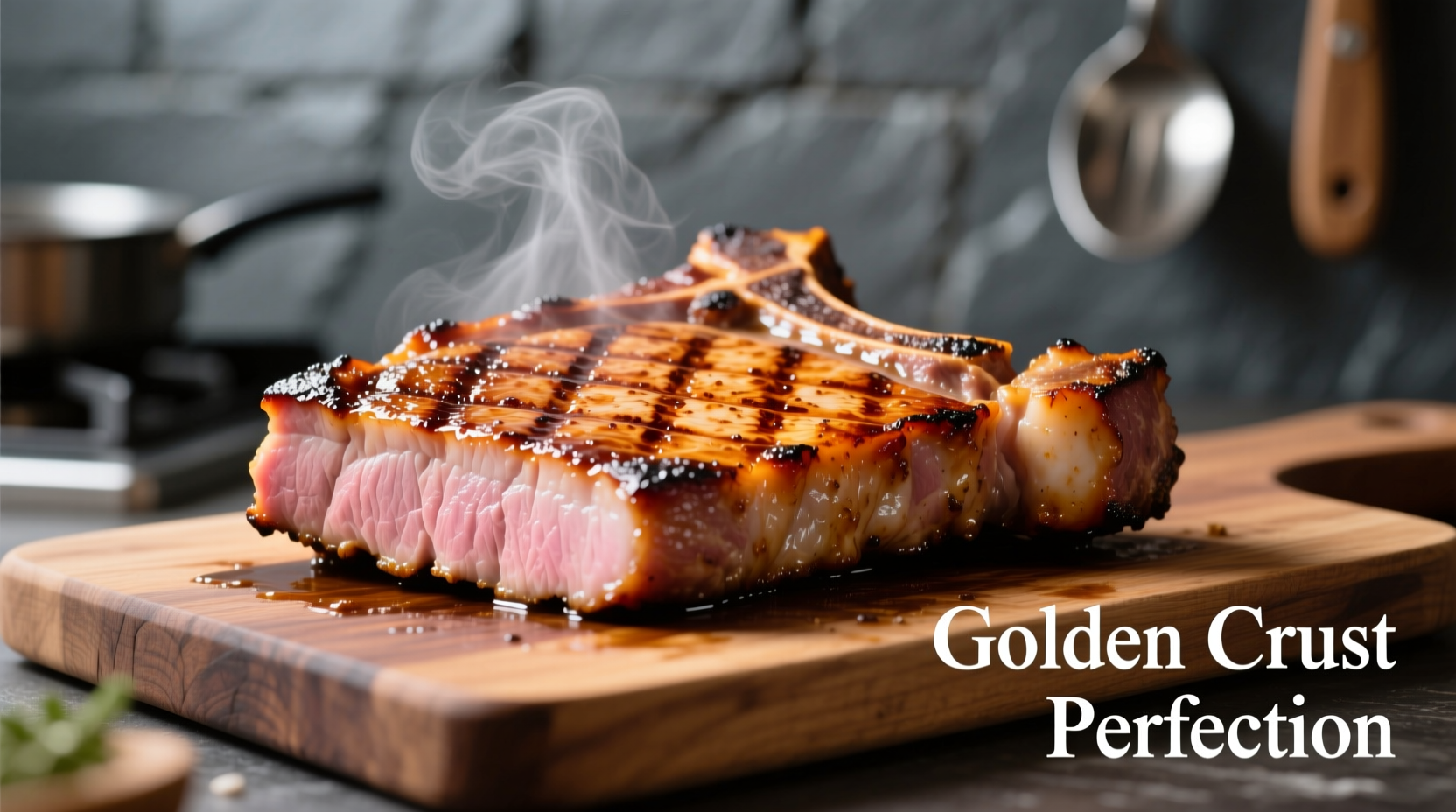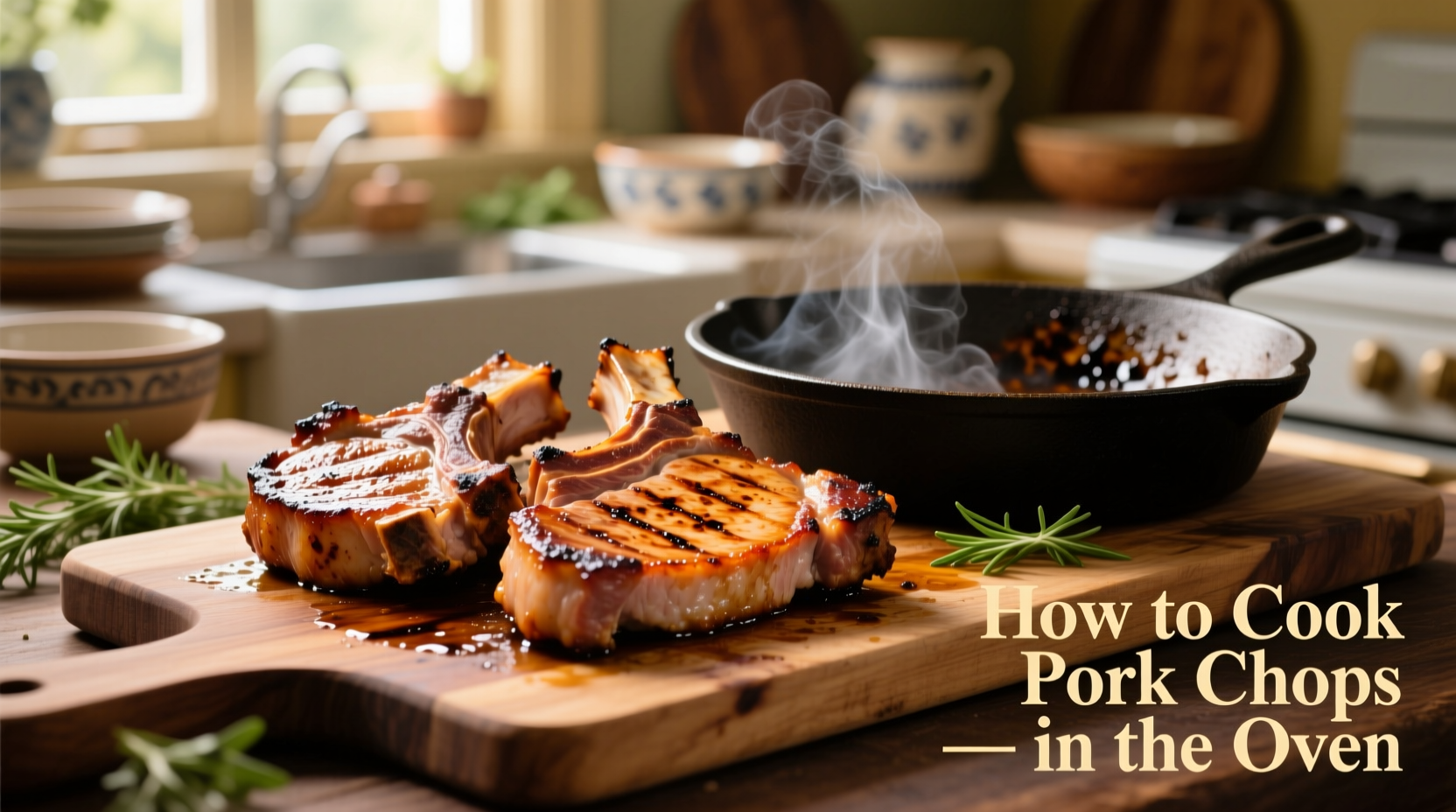The perfect oven-baked pork chop requires a preheated 400°F (204°C) oven, 15-20 minutes cooking time depending on thickness, and a final internal temperature of 145°F (63°C) with a mandatory 3-minute rest period. This method delivers juicy, flavorful results with a beautiful crust while ensuring food safety according to USDA guidelines.
Why Oven-Baked Pork Chops Outperform Other Methods
Many home cooks struggle with dry, tough pork chops because they either undercook them (due to outdated safety fears) or overcook them trying to avoid perceived risks. Modern pork is leaner and safer than ever before, and the oven method provides precise temperature control that prevents both problems. Unlike stovetop cooking which requires constant attention, the oven approach allows for hands-off cooking with consistent results.
Essential Equipment Checklist
Before you begin, gather these kitchen essentials:
- Oven-safe meat thermometer (digital recommended)
- Heavy-bottomed oven-safe skillet or cast-iron pan
- Baking sheet with wire rack (alternative method)
- Aluminum foil for resting
- Sharp chef's knife for trimming
Selecting the Perfect Pork Chop
Not all pork chops work equally well for oven cooking. Bone-in chops (1-1.5 inches thick) retain moisture better than boneless varieties. Look for "pasture-raised" or "heritage breed" options when possible, as these typically have better marbling. The USDA recommends choosing chops with "fresh" color (light pink to reddish-pink) and minimal liquid in the package.
| Pork Chop Type | Best For Oven? | Recommended Thickness | Cooking Time Adjustment |
|---|---|---|---|
| Loin (T-bone) | Excellent | 1.25-1.5 inches | Standard timing |
| Rib | Excellent | 1-1.25 inches | Reduce by 2-3 minutes |
| Sirloin | Good | 1-1.25 inches | Reduce by 3-4 minutes |
| Boneless center cut | Fair | 0.75-1 inch | Reduce by 4-5 minutes |
Pre-Cooking Preparation Timeline
Proper preparation makes the difference between mediocre and exceptional results. Follow this timeline for best outcomes:
- 30 minutes before cooking: Remove chops from refrigerator and pat thoroughly dry with paper towels. Moisture prevents proper browning.
- 20 minutes before cooking: Season generously with salt (1/2 teaspoon per side) to enhance flavor and texture.
- 10 minutes before cooking: Preheat oven to 400°F (204°C) with rack positioned in the center.
- 5 minutes before cooking: Apply additional seasonings and let sit at room temperature.
Step-by-Step Cooking Process
Dry Brining and Seasoning
Salt your chops 30 minutes before cooking—this isn't just for flavor. The salt draws out moisture initially, then gets reabsorbed along with the meat's natural juices, creating a more flavorful and tender result. For a standard 1-inch thick chop, use 3/4 teaspoon of kosher salt total (divided between both sides).
Searing for Flavor Development
Heat 1 tablespoon of high-smoke point oil (avocado or grapeseed) in your oven-safe skillet over medium-high heat until shimmering. Sear chops for 2-3 minutes per side until golden brown. This Maillard reaction creates complex flavor compounds that oven cooking alone cannot achieve. According to USDA food safety guidelines, this initial sear helps destroy surface bacteria before the oven phase.

Oven Cooking Method
Transfer the skillet directly to your preheated oven. Cook for 8-12 minutes for 1-inch thick chops, or until a digital thermometer inserted horizontally into the thickest part reads 135°F (57°C). Remember that temperature will continue rising during resting. Thicker chops may require up to 15 minutes. For best results, avoid opening the oven door during cooking.
Resting: The Critical Final Step
Transfer chops to a wire rack and tent loosely with foil. Rest for exactly 3 minutes—this allows juices to redistribute throughout the meat. Cutting too soon releases precious moisture onto your cutting board rather than staying in the meat. During this rest, the internal temperature will rise to the USDA-recommended 145°F (63°C) minimum.
Avoiding Common Mistakes
Even experienced cooks make these critical errors:
- Overcrowding the pan: Cook no more than 2 chops in a standard 10-inch skillet to ensure proper browning
- Using the wrong thermometer: Instant-read thermometers are essential; don't rely on timers alone
- Skipping the rest period: Cutting immediately after cooking loses up to 40% of the juices
- Under-seasoning: Pork chops need more salt than you might expect due to their mild flavor
Flavor Variations and Customizations
Once you've mastered the basic technique, experiment with these professional variations:
- Herb crust: Press fresh thyme, rosemary, and sage into the chops before searing
- Garlic butter finish: Add 2 tablespoons butter, 2 garlic cloves, and a sprig of rosemary to the pan during the last 2 minutes of oven time
- Mustard crusted: Brush with Dijon mustard and coat with panko breadcrumbs before oven phase
- Sweet and savory: Create a glaze with apple cider, brown sugar, and a splash of bourbon
Food Safety and Storage Guidelines
Proper handling ensures your delicious pork chops remain safe to eat:
- Always cook to a minimum internal temperature of 145°F (63°C) with 3-minute rest
- Store leftovers within 2 hours of cooking in airtight containers
- Consume refrigerated leftovers within 3-4 days
- Reheat to 165°F (74°C) using gentle methods to prevent drying
The CDC's temperature danger zone guidelines confirm that cooked pork should not remain between 40°F and 140°F for more than 2 hours to prevent bacterial growth.
Troubleshooting Guide
Encountering issues? Try these solutions:
- Dry results: You're likely overcooking. Invest in a reliable thermometer and remove chops at 135°F
- Pale appearance: Pat chops drier before searing and ensure your pan is properly preheated
- Burning: Reduce oven temperature to 375°F for thinner chops or if using sugar-based marinades
- Uneven cooking: Rotate the skillet 180 degrees halfway through oven time
When Oven Cooking Isn't Ideal
While oven-baking works well for most situations, consider these context boundaries:
- Chops thinner than 3/4 inch: Use stovetop-only method to prevent overcooking
- Marinated chops with high sugar content: Broil instead to prevent burning
- Very thick chops (over 1.5 inches): Sear then finish at 325°F for more even cooking
- When outdoor cooking is available: Grilling provides superior flavor development











 浙公网安备
33010002000092号
浙公网安备
33010002000092号 浙B2-20120091-4
浙B2-20120091-4